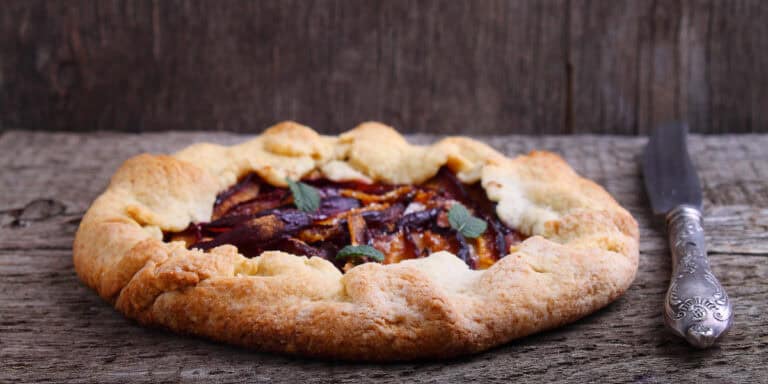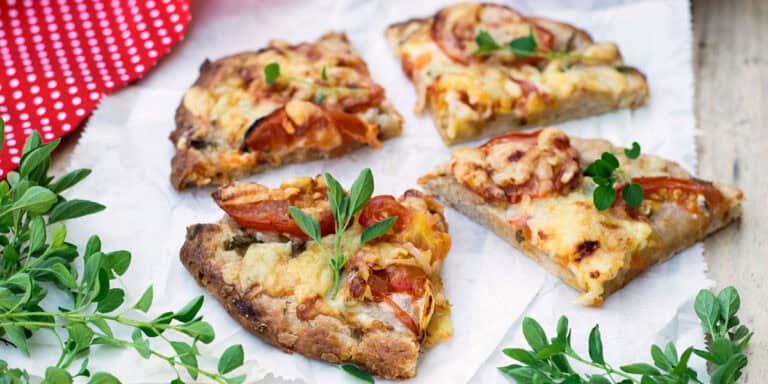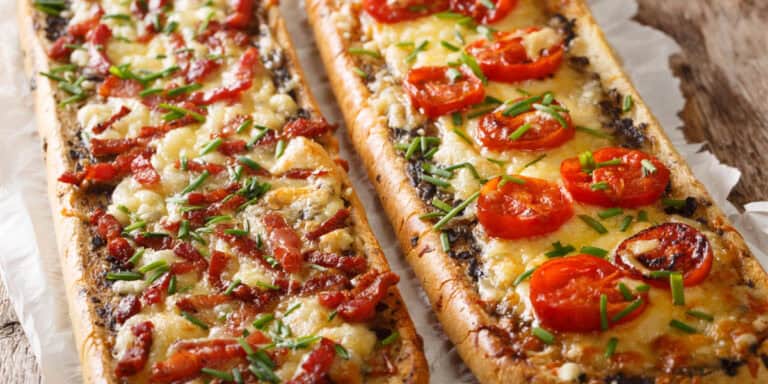Pizza Crust Tips
Are you tired of lacklustre pizza crusts that don’t hit the mark? Look no further! This article will give expert tips and tricks to elevate your pizza game. Whether you’re craving a crispy, thin crust or a chewy, deep-dish delight, we’ve got you covered.
Discover the secrets behind perfect dough resting, essential ingredients for flavour-packed crusts, and troubleshooting common issues. Get ready to create innovative and sensational pizza crusts that will leave your taste buds begging for more!
Types of Pizza Crusts
If you want a crispy crust, try using a thin pizza dough. Thin-crust pizzas are famous among pizza lovers who crave a light and crispy bite. The secret to achieving the perfect thin crust lies in the dough itself. Made with less yeast and rolled out thinly, this crust allows for even heat distribution during baking, resulting in a deliciously crunchy texture.
But what about those who prefer something more substantial? Enter the deep-dish crust. This thick and hearty crust is perfect for those who love an indulgent and filling slice of pizza. With their buttery and flaky texture, deep-dish pizzas are often loaded with layers of cheese, sauce, and toppings.
Both thin crust and deep dish offer unique experiences that cater to different preferences. While thin crust provides a delicate balance between toppings and dough, allowing each ingredient to shine through, deep dish offers a more decadent option with its generous layers of flavours.
Whether you’re in the mood for something light or craving a rich and satisfying meal, experimenting with different types of pizza crusts can elevate your pizza game to new heights. So go ahead and explore the world of pizza crusts—innovation awaits!
The Importance of Proper Dough Resting
Give your dough enough time to rest before shaping it to ensure a light and airy texture. Proper dough resting plays a crucial role in achieving the perfect pizza crust. When you mix the ingredients for your dough, gluten is formed. Gluten gives the dough structure and elasticity, allowing it to rise and hold its shape during baking. Allowing the dough to rest allows the gluten strands to relax and develop further, resulting in a more tender and chewy crust.
The impact of hydration levels also cannot be underestimated when achieving an exceptional pizza crust. The hydration level refers to the amount of water used and flour in the dough. A higher hydration level creates a wetter and stickier dough, which can result in a lighter and more open crumb structure.
During the resting period, both gluten development and moisture absorption co-occur. This allows for better flavour development and improved texture in your final pizza crust.
So remember: give your dough ample time to rest before shaping it for your pizzas. This will allow for optimal gluten development and moisture absorption, resulting in a light, airy, and delicious pizza crust that will leave everyone wanting more.
Essential Ingredients for a Perfect Pizza Dough
When making your perfect pizza dough, choose high-quality ingredients such as flour, yeast, water, and salt. These essential ingredients build a delicious crust that will impress even the most discerning pizza connoisseur.
Let’s start with the flour. You can use different types of flour for your pizza dough, each offering its unique characteristics. All-purpose flour is a popular choice as it strikes a good balance between chewiness and crispness. Consider using bread flour for a lighter crust with more air pockets. Whole wheat flour is an excellent option for those with a nuttier flavour and slightly denser texture.
Next up is yeast—the magical ingredient that makes your dough rise. Various types of yeast are available in the market. Active dry yeast is the most commonly used type and requires proofing before use. Instant yeast, on the other hand, can be added directly to the dry ingredients without proofing. Rapid-rise yeast acts similarly to instant yeast but has smaller granules that dissolve faster.

Tips for Achieving a Crispy Crust
Preheat your oven to the highest temperature possible for a crispy crust. Using the proper techniques is key to achieving the perfect texture for your pizza crust.
The first step is to create a dough with the ideal balance of ingredients, as discussed in our previous subtopic on essential elements for a perfect pizza dough. Once you have prepared your dough, it’s time to focus on achieving that delightful crispiness.
One technique for achieving a crispy crust is using a pizza stone or steel. Preheat your stone or steel in the oven and place your pizza directly on top. The hot surface will rapidly heat the bottom of the crust, resulting in a crunchy texture.
Another technique is to bake your pizza in a high heat setting for a shorter period. This allows for quick cooking, which helps maintain moisture within the crust while keeping it nice and crispy.
To enhance crispiness further, consider brushing olive oil onto the edges of your crust before baking. This creates an extra layer of flavour and adds to its crunchiness.
Remember that achieving the perfect crispy crust requires practice and experimentation. So don’t be afraid to try different techniques until you find one that works best. Enjoy exploring these innovative approaches to creating an irresistibly crispy pizza crust!
How to Create a Chewy Pizza Crust
If you want to create a chewy pizza crust, there are three key factors to consider:
-
The type of flour you use: Different flours can affect the texture of your crust, with high-protein flours like bread flour or Tipo 00 flour being great options for achieving chewiness.
The yeast and rising time: The amount of yeast used and the length of the rising time can impact the final result. The key is to find the right balance between a warm environment for yeast activation and allowing enough time for fermentation.
-
The baking temperature and duration: Baking at a high temperature for a shorter time can help create that desired chewy texture while ensuring a crispy outer layer.
Flour Types for Chewiness
Using bread flour instead of all-purpose flour will give your pizza crust a chewier texture. Bread flour has a higher protein content, which creates more gluten when mixed with water. This results in a firmer, more elastic dough that gives the crust its desired chewiness. If you’re looking to experiment with alternative flours for different crust textures, here are some options:
| Flour Type | Texture | Characteristics |
|---|---|---|
| Whole Wheat | Nutty | It gives the crust a slightly gritty texture that provides extra bite and crunch, and it is often used in traditional Italian pizza dough recipes. |
| Semolina | Coarse | It provides a unique flavour profile and can result in a denser and darker crust. |
| Rye | Earthy | It provides a unique flavor profile and can result in a denser and darker crust. |
These alternative flours can add variety to your pizza-making adventures, allowing you to explore different textures while still achieving that perfect chewiness in your crust.
Yeast and Rising Time
To achieve a perfectly risen dough, use active dry yeast and allow enough time for it to activate and the dough to double in size.
Active dry yeast is a popular choice for pizza crust because it needs to be dissolved in warm water before adding it to the flour mixture. This allows the yeast to activate and ferment, releasing carbon dioxide gas to make the dough rise.
Once activated, the yeast needs time to work its magic. Letting the dough sit at room temperature for about an hour or until doubled in size will give you a light and fluffy crust. During this rising time, gentle kneading techniques can also help distribute the yeast evenly throughout the dough, resulting in a more uniform rise. So don’t rush the increasing process – give your yeast and dough ample time to create that perfect pizza crust!
Baking Temperature and Duration
Preheat the oven to the recommended temperature before baking your pizza for a golden and crispy result. The baking temperature is a crucial factor in achieving the perfect crust texture.
Different types of pizza dough require different temperatures to bake correctly. Thin-crust pizzas typically need higher temperatures, around 475°F (245°C), to ensure they become crispy without burning. On the other hand, thicker crusts benefit from lower temperatures, around 425°F (220°C), to allow for slower, more even cooking.
Baking techniques also play a role in determining the desired crust thickness. Stretching or rolling the dough thinly for a thinner crust will yield fantastic results. If you prefer a thicker crust, allowing the dough to rise longer before baking can help achieve the desired airy and chewy texture.

Secrets to a Flavorful Pizza Crust
When creating a flavorful pizza crust, you may consider yeast or sourdough. Both options have unique advantages and can significantly impact the taste and texture of your crust.
Another factor to consider is whether to pre-bake your crust. This step can help achieve a crispy exterior while maintaining a soft interior.
Lastly, don’t underestimate the importance of choosing the right flour type for your dough. Different flours, such as all-purpose or bread flour, can significantly influence the flavour profile of your pizza crust.
Yeast or Sourdough?
If you’re torn between yeast or sourdough, consider the flavour and texture each option brings to your pizza crust. Yeast is a popular choice for its convenience and quick rise time. However, sourdough might be the way to go if you want a more complex and authentic taste. Sourdough is made by fermenting dough with wild yeasts and bacteria, resulting in a tangy flavour and chewy texture that can’t be replicated with commercial yeast alone.
Here’s a table that compares the benefits of yeast and sourdough:
| Yeast | Sourdough | |
|---|---|---|
| Flavor | Mild | Tangy |
| Texture | Soft | Chewy |
| Digestibility | Moderate | High |
| Nutritional Benefits | Limited | Abundant |
As you can see, sourdough offers additional benefits such as improved digestibility and increased nutritional value compared to yeast. So why not give it a try next time you make pizza? Your taste buds will thank you!
Pre-Bake or Not?
To achieve a crispy crust, pre-bake it for a few minutes before adding your toppings. Pre-baking the pizza crust has several benefits.
Firstly, it helps to ensure that the crust is fully cooked and not soggy in the center. This is especially important if you like a thin and crispy crust.
Secondly, pre-baking allows the crust to develop a nice golden colour and adds an extra layer of flavour. The heat from the oven caramelizes the sugars in the dough, resulting in a deliciously savoury taste.
If you’re looking for alternatives to pre-baking, one option is par-baking the crust by partially cooking it before adding toppings. Another alternative is using a pizza stone or baking steel, which can help to create a crispy crust without pre-baking.
Experimenting with different methods can lead to innovative and delicious results!
Flour Types Matter?
Different flour types can affect the texture and flavour of your homemade pizza. Choosing the suitable flour for your crust is essential to achieve that perfect balance of chewiness and crispiness.
Here are four different flour options you can consider:
-
All-purpose flour: This is the most commonly used flour for pizza dough. It has a moderate protein content, which helps in gluten formation and gives the crust a soft texture.
-
Bread flour: With a higher protein content than all-purpose flour, bread flour creates a chewier crust. It also provides a better structure and can handle toppings well without becoming soggy.
Whole wheat flour: For a healthier option, whole wheat flour adds nuttiness and fibre to your crust. However, it produces a denser crust than all-purpose or bread flour.
-
Gluten-free flour blend: If you have dietary restrictions or prefer gluten-free options, various combinations mimic the texture of traditional pizza dough.
Experiment with these different flours to find your favourite combination and create an innovative pizza experience at home!
The Role of Yeast in Pizza Dough
Yeast is essential in creating a light and fluffy pizza crust. It plays a crucial role in developing the dough’s flavor and texture. Different types of yeast can be used for pizza dough, each offering unique characteristics.
To understand the importance of yeast in pizza dough, let’s take a look at the table below:
| Type of Yeast | Characteristics |
|---|---|
| Active Dry | Most commonly used, it must be activated by dissolving in warm water before use. |
| Instant | Quick and easy to use; does not require activation and can be added directly to dry ingredients |
| Fresh | It provides a slightly sweeter flavor, requires refrigeration, and has a shorter shelf life. |
The type of yeast you choose will impact your pizza crust’s taste and texture. For example, active dry yeast may produce a slightly chewier crust than instant yeast. On the other hand, fresh yeast can add a subtle sweetness to your dough.
Experimenting with different types of yeast can lead to exciting innovations in your pizza-making process. Understanding their characteristics allows you to create personalized flavours and textures that elevate your pizza. So go ahead, explore the world of yeasts, and unleash your creativity!
Troubleshooting Common Pizza Crust Issues
Are you having trouble with your pizza dough? Let’s tackle some common crust issues and find solutions to make your homemade pizzas perfect every time.
One of the most frustrating problems is dealing with dough elasticity. If your dough is too elastic, it can be challenging to shape and stretch properly. Try reducing the water in your recipe or adding more flour to troubleshoot this issue. This will help create a firmer and less stretchy dough, making it easier to work with.
Another common concern is achieving a golden crust colour. To achieve that beautiful golden hue, you can try a few tricks. First, preheat your oven to the highest temperature possible for at least 30 minutes before baking your pizza. This will ensure the heat is evenly distributed throughout the range, resulting in a crispier crust.
Additionally, brushing the edges of your pizza crust with olive oil or melted butter before baking can enhance browning and add flavour. You can also sprinkle cornmeal on the bottom of your baking surface to prevent sticking and promote browning.






